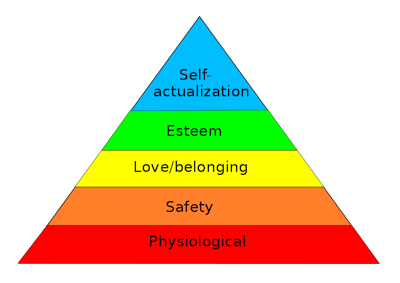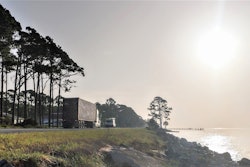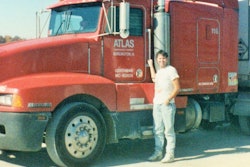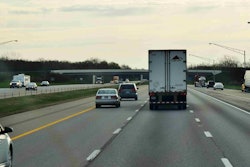At the most basic level, a driver needs food, water, warmth and rest. With the trucks offered by most companies today, along with ELDs disincentivizing everyone to push, warmth in a decent place to rest and the time to do it is pretty well covered. … (Provided, of course, that safe parking can be found – but that’s on up to the next level of needs on social psychologist Abraham Maslow’s pyramid of needs – more about that level later.)
 Read more about Maslow’s hierarchy via this link. | Image by FireflySixtySeven, based on Maslow’s paper, “A Theory of Human Motivation.” CC BY-SA 4.0
Read more about Maslow’s hierarchy via this link. | Image by FireflySixtySeven, based on Maslow’s paper, “A Theory of Human Motivation.” CC BY-SA 4.0Given most are in trucking to support their families, let’s not forget that all those needs must be covered for the driver’s family as well. If momma (or daddy, as it were) is not happy, I guarantee momma’s (or daddy’s) driver’s not going to be happy.
As I have noted before, drivers are pretty much being paid today what they were paid in 1982, and when it comes to buying power a fair amount less than that – sad, but true. By the end of 1982 the average home sold for about $71,000 dollars. Today that same home sells for near $230K, a threefold-and-more increase.
The average cost of a new car in the 1980s was about $7K, and gas for that car averaged 90 cents a gallon. You get the point. Driver pay is such that, at many companies today, drivers’ most basic needs at the bottom of the pyramid are not being met. But let’s move on to the next level: Safety.
As parenthetically intimated above, inadequate parking presents a big red flag here. What else can be done to improve safety for drivers? If you want to employ women over-the-road, think about personal body alarms or parking alternatives — many of our truck stops are not well lit, and walking from the back of a three- or four-acre lot to use a bathroom in the middle of the night can be daunting.
At once, another need under the safety umbrella could be health — we must stay healthy to maintain our medical certifications, and part of being safe on the road is being healthy. But very few companies place much (if any) emphasis upon health, and health issues are a major concern for drivers and their families who depend upon their income. This should also include mental health, since stress-related issues are quickly becoming the No. 1 health concern in the United States.
The next level of needs is in relationships – “love/belonging” in the pyramid above. We’ve already covered what happens when momma/daddy isn’t happy, and with communications technology it is much easier for drivers to stay connected with home. Still, there is room for improvement — enable Wi-Fi hotspots in the trucks for drivers. Auto manufactures have been putting Wi-Fi capabilities in their cars for years now, so it is not much of a stretch. Today a driver may not be able to attend that ball game or recital in person, but with Wi-Fi and a phone they can easily be there virtually.
Drivers can become disconnected from their communities because they are gone so much, but simple things like church services, picnics, maybe a company fishing derby for drivers in the area can go a long way.
Next, Maslow shows us that esteem and prestige are necessary. Simply put, this level of the pyramid points the way for acknowledging accomplishments: There is not one single driver on the road who has reached that 1, 2, or 3-million-mile safe driving mark who is not proud of that accomplishment. Most companies are very good at bragging about that as a recruiting tool. But what else could they do?
Money is always nice, but it takes close to ten years to hit the 1-million-mile mark. Along the way, perhaps it makes sense to give a driver a stake in the company via profit-sharing and/or employee-ownership schemes. A vested interest in the company would no doubt give an operator a sense of appreciation and a tangible reason to remain employed by a fleet.
The generations coming up are looking for companies to be committed to the communities they belong to, companies that with them support charities and/or local environmental issues. My company does a breast-cancer biker run every year to raise money for breast cancer. They encourage the safety needed for drivers to participate in both sate and (with skill) national truck rodeos.
Finally, we come to self-actualization, or achieving one’s full potential. The trucking industry is one of the few industries where there doesn’t seem to be a ceiling including glass to be broken. Man or woman, a driver can be a company driver their entire career, they can become a small business by owning and building their own trucking company — but for too many, that’s about it. Few opportunities exist outside the truck that a driver can move into and expect the same or better income.
While I have known some drivers who tried dispatching, most have gone back to driving. Some have tried to become brokers, some with success, but sales often proves a whole new ballgame.
Very few find the opportunity to advance for accomplishment or for a better family life.
As with so many trucking issues, that brings us back to pay. Without money, the first basic needs, on which the entire pyramid sits, cannot be met. Last year drivers saw movement. Some companies started salary-type programs at above-average rates; others went to hourly wages and/or minimum weekly guarantees. With ELDs we have begun to more short hauls and drop-and-hook operations (the latter an expensive undertaking). The FMCSA has hinted at more flexibility. These help, but drivers need a sense of pride. How can we bring that back?











